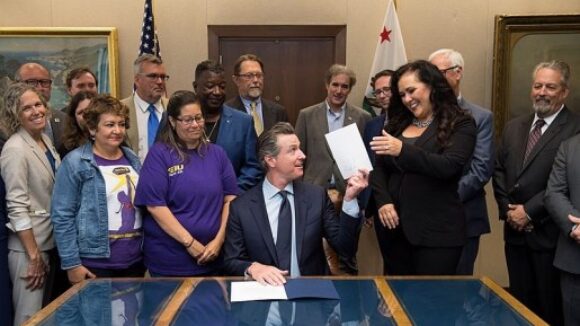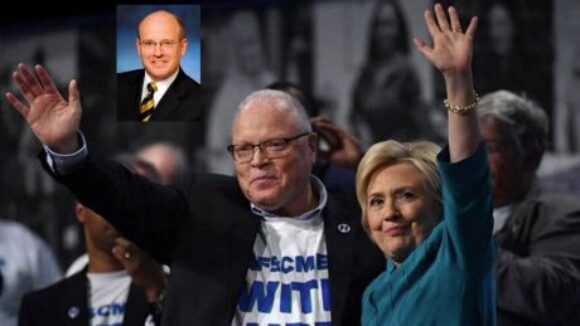‘People Have a Right to Make Their Own Choice’
Avelo employee Kim Howard believes all the firm’s flight attendants should get to vote on continued AFA rule. Credit: WTNH-TV (ABC,…
Big Labor Spends How Much on Politics?

Union Electioneering/Lobbying Cost Over $2 Billion in 2018 Election Cycle
Drawing on data furnished by four major public-disclosure resources, the National Institute for Labor Relations Research has recently, and conservatively, estimated that Big Labor spent more than $2 billion on politics and lobbying in 2017 and 2018.

The Institute’s fact sheet analyzing union bigwigs’ expenditures over the past two years intended to “influence the selection, nomination, election, or appointment of anyone” to “public office” and/or mold public policy through other means was published on April 23.
(To access a copy, go to https://nilrr.org/2019/04/23/big-labor-the-number-one-special-interest-spent-2-billion-to-influence-the-2018-elections/ on the Internet.)
Big Labor Controls the Most Massive Political Machine in America
The Institute’s analysis relies almost entirely on reporting forms filed by union officials themselves with federal and state government agencies.
Poor-mouthing union chiefs and supposedly “nonpartisan” monitors like the Center for Responsive Politics have long fostered the false impression that Big Labor PAC and Section 527 expenditures, respectively reported to the Federal Election Commission and the IRS, represent all union-boss electioneering.

But the LM-2 forms that unions with annual revenues exceeding $250,000 and at least some private-sector members are required to file with the U.S. Labor Department, along with other publicly available resources, show union officials actually control by far the most massive political machine in America.
Federal Law Forces Private-Sector Workers To Bankroll Unions
In 2003, then-President George W. Bush’s Labor Department revised LM-2 forms with the avowed goal of helping millions of private-sector workers who are forced to pay union dues or fees as a job condition get a better idea of where their conscripted money is going.
This was a worthwhile initiative.
Current federal laws, as interpreted by the judiciary, authorize the firing of private-sector employees for refusal to pay for unwanted union monopoly bargaining, unless the employees are protected by a state Right to Work law.
But the U.S. Supreme Court, in multiple precedents argued and won by National Right to Work Legal Defense Foundation attorneys, has established that private-sector employees may not legally be terminated for refusal to pay for Big Labor’s non-bargaining activities — regardless of where they live.
And just last year, the High Court concluded in the Foundation case it most recently heard, Janus v. AFSCME Council 31, that the extraction of forced union dues and fees from public-sector workers to bankroll any union activity violates the First Amendment and is therefore prohibited.
Unfortunately, in a misguided and futile attempt to appease the union brass, Bush officials failed to require private- sector union reports to strictly segregate all bargaining and non-bargaining activities in the revised LM-2’s.
Nevertheless, since the LM-2 revision withstood an extended Big Labor court challenge and took effect roughly 15 years ago, union officials have been required to report each year how much they spend on two major non-bargaining activities — electioneering and lobbying.
The Institute review of all LM-2 forms filed for 2017 and 2018 shows that unions filing such forms spent a total of $1.37 billion from union treasuries, which overwhelmingly consist of forced and coerced union dues and fees, on “politics and lobbying” over those two years alone.
Forced Dues-Stocked Union Treasuries Finance Get-Out-the-Vote Activities
Such forced dues-fueled spending pays for phone banks, get-out-the-vote drives, propaganda mailings, and other so-called “in-kind support” for candidates.
As a front-page Wall Street Journal article by Tom McGinty and Brody Mullins published in July 2012 explained, a large share of Big Labor’s forced dues-funded political war chest is spent “paying teams of political hands to contact members [and their families].”
The political hands’ job is browbeating all the voters in union households into agreement with union official positions on election issues and “trying to make sure they vote for union-endorsed candidates.”
Though the Journal article didn’t mention it, a second important function of forced dues-bankrolled union political operatives is to push up turnout in neighborhoods where, Organized Labor calculates, a very high share of voters will cast their ballots for union-endorsed candidates.
Big Labor political and lobbying expenditures reported on LM-2 forms are the single largest component of the union electioneering machine.
Many Deeply Political Unions Don’t Have To File LM-2’s
But there is plenty LM-2’s don’t cover.
“Government unions that have no private-sector members, including many affiliates of the National Education Association union and other deeply political state and local unions, don’t have to file LM-2’s,” noted Mark Mix, president of the Right to Work Foundation and the National Right to Work Committee.
“The Institute analysis identified political spending by such government unions as reported to state and local government monitors, and tracked on the FollowTheMoney.org web site.
“In the aggregate, such reports show union bosses spent a total of $479 million on state and local politics in 2017 and 2018.”
Many Political Expenditures Appear to Be Mislabeled as ‘Contributions’ or ‘Gifts’
“Union PAC and ‘527 group’ expenditures not reported elsewhere add another $144 million to the 2017-18 war chest,” Mr. Mix continued.
“Unlike business and other interest-group political spending, Big Labor’s ‘in-kind’expenditures on politics are financed largely by forced-dues and forced-fee money, often paid by workers who aren’t union members and who personally oppose the union-boss agenda.
“Compulsory-dues privileges made it possible for Big Labor to spend more than $2 billion on electioneering and other ideological schemes over the past two years.”
One should consider $2 billion to be a conservative estimate, explained Mr. Mix, because the Institute opted virtually to ignore the $514 million in supposedly nonpolitical, non-lobbying “contributions, gifts and grants” LM-2-filing unions reported making in 2017 and 2018.
“It’s reasonable to estimate that at least half of the $500 million in contributions, gifts and grants that Big Labor didn’t classify as ‘political’ were, in reality, political,” he said.
“For example, union bosses made millions of dollars in putatively ‘nonpolitical’ contributions to the radical Democracy Alliance’s ‘State Victory Fund’ and the anti-Right to Work front group ‘We Are Missouri.’
“Out of extreme caution, the Institute chose to count less than 3% of the $514 million in union contributions and gifts as political, although the reality is that hundreds of millions of dollars categorized as such evidently went to political and ideological groups.
“Fortunately, throughout the 2019-20 election cycle, public-sector employees in all 50 states will enjoy Right to Work protections thanks to the Supreme Court’s Janus decision, argued and won by Foundation staff attorney William Messenger.
“Moreover, 27 states now have Right to Work laws on the books prohibiting forced union membership, dues and fees in the private sector.
“Along with civil servants, private-sector employees in Right to Work states are protected from being forced to bankroll Big Labor’s favored causes and candidates.”
Federal Lawmakers Have An Obligation to Act To Protect the First Amendment
But it remains Congress’ obligation to crack down on forced-dues politicking and protect the free-speech rights of private-sector employees across the nation.
This objective can be accomplished through passage of a national Right to Work law that repeals the handful of provisions in federal labor law under which millions of employees are still being forced to bankroll unions.
Legislation known as the National Right to Work Act has been introduced in the U.S. Senate as S.525 and is expected to be introduced very soon in the U.S. House.
Once federal forced-dues repeal measures are before both the Senate and the House, the Committee will begin mobilizing freedom-loving citizens nationwide to push for committee hearings and floor votes.
(source: June 2019 National Right to Work Newsletter)
If you have questions about whether union officials are violating your rights, contact the Foundation for free help. To take action by supporting The National Right to Work Committee and fueling the fight against Forced Unionism, click here to donate now.

Avelo employee Kim Howard believes all the firm’s flight attendants should get to vote on continued AFA rule. Credit: WTNH-TV (ABC,…

California’s Big Labor-concocted A.B.5, signed into law by Gov. Gavin Newsom in 2019, made it almost impossible for workers and firms to bounce back after 2020’s COVID-19 lockdowns. Now Biden bureaucrats want to federalize A.B.5!

Mr. Fain undoubtedly knows full well that there is a complete disconnect between the UAW hierarchy and the UAW rank-and-file on the Biden presidency and whether workers will benefit from its extension for another four years.